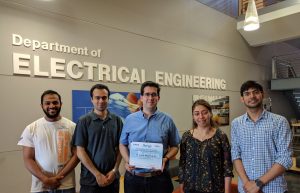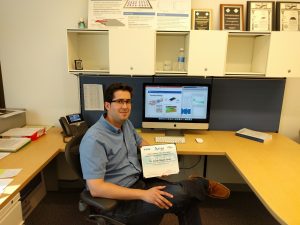Earlier this year, at ICC 2017 in Paris, we have given the IEEE ComSoc YPs and WICE Best Innovation Award to Dr. Josep Miquel Jornet, who is currently Assistant Processor at the University of Buffalo. We were inspired by his work, so we asked him a few questions about his research and also asked for some directions for young researchers. We hope you will enjoy reading his answers.

ComSoc YP: Hi Josep, could you please tell us about your education background and professional working experience.
Josep: I received the BS and MS degrees on Telecommunications Engineering from the Universitat Politècnica de Catalunya (UPC), Barcelona, Spain in 2008. My first contact with research occurred when I was an undergraduate student (2006-2007) in the Antenna Lab at UPC. At that time, I was working on the design of antennas for Ultra-Wide-Band applications. Between 2007 and 2008, I moved to the Massachusetts Institute of Technology (MIT) as a visiting student, where I worked on the design of networking protocols for underwater acoustic networks. In 2009, I joined the Broadband Wireless Networking Laboratory at the Georgia Institute of Technology, as a Ph.D. student under the supervision of Professor Ian F. Akyildiz. My dissertation topic was something radically different and radically new: nanoscale communication networks. I graduated in August 2013 and, one week later, I joined the University at Buffalo (UB) as an Assistant Professor in the Department of Electrical Engineering.
ComSoc YP: Could you describe what you are working on in max 150 words?
Josep: I am currently working on wearable nano-biosensing networks, a novel communications-enabled approach to the broad field of nano-biosensing. With a team of great researchers at UB, I am developing new devices and communication algorithms which allow us to activate and measure the response of implanted nano-biosensors. As opposed to traditional nano-biosensing techniques, which rely on a single point of excitation (a laser) and measurement (a spectrum analyzer), we utilize a network of nanophotonic devices (nano-lasers, nano-detectors), integrated on a wearable device (a smart band), to jointly excite and estimate the response of the implanted nano-biosensor. While this might seem far from a traditional communication network, we are dealing with a group of nano-devices (users) that jointly estimate the status of a nano-sensor (target) by exchanging optical signals (information) that travel through the body (channel).
ComSoc YP: How did your work evolve and how did you become engaged with this great project?
Josep: When I was a Ph.D. student, my focus was on nanoscale communication networks at Terahertz (THz) frequencies (from 100 GHz to 10 THz). When I moved to UB, in addition to continue my work in the THz band, I decided to explore even higher frequencies, e.g., optical frequencies (>100 THz). Light is commonly used for medical imaging and biosensing. When talking to my colleagues who work in the field of nano-biosensing, it was clear that while the sensors are “nano in size”, they require “macro-sized and macro-priced equipment” to read them. At that point, I realized that we could do much better by replacing the macro-sized equipment by a network of nano-devices that cooperatively accomplish the task. For three years, we investigated the feasibility of this approach and the requirements on the devices. We started to work with nanophotonic device experts, who are now in the team, as well as biomedical engineers who can exactly explain us how the biological aspects of the system work. Suddenly, we had a team of people with expertise ranging from electronics, photonics and wireless communication to biology and medicine. In an attempt to prove the system feasibility experimentally, we had to identify a specific biomarker to sense, for which we focused on lung cancer. This is how the Roswell Park Cancer Research Institute entered the picture. In addition, we needed to explore the feasibility of turning this idea into a product: suddenly we are in talks with Intel Labs (wearable technology) and Garwood Medical Devices (implantable devices). Together, as a team, we have now been awarded a $1M NSF project to experimentally demonstrate the feasibility of our technology in 3 years.
ComSoc YP: What would you suggest to young researchers to look at in the nano-IoT/health area?
Josep: Many people are afraid to go into the Internet of Nano-Bio-Things (IoNBT) because they have not received training in nano- or bio-technologies. However, the good news is that you don’t need to be an expert in the nano-bio-fields to make a contribution to the IoNBT, but you should have the motivation and energy to meet with nano- and bio-experts and define a common language. After that, there is work for everybody. For example, the way in which electromagnetic signals (whether at optical or THz frequencies) propagate in the body is very different than traditional wave propagation, and thus requires the development of new channel models. Based on the channel and what the nano-devices can achieve, new physical layer solutions are needed to ensure that two devices can communicate in and out of the body in a biocompatible way. In addition, people are usually worried about privacy and security, and they should be so even more if the information that is being exchanged is as sensitive as whether the user has cancer or, even more, it contains a snapshot of the user’s DNA. When looking for the solutions to these challenges, keep in mind that the only thing we cannot break are the laws of physics, but technology limitations will be eventually cleared, whether because the technology improves or because a totally different technology comes in. Think of nanotechnologies and all the opportunities that they bring to us, engineers!

ComSoc YP: What would be the impact of your proposed work on the communications fields or humanity at large?
Josep: Our goal is to transform the field of nano-bio-sensing and, ultimately, revolutionize healthcare systems. In the same way that by adding communications to a house or a car, the communications community enabled smart homes and smart cars, by adding communication to nano-bio-sensing devices we can create smart nano-bio-sensing systems. Our group is aimed at bridging the gap between nano-bio-sensing technologies and commercial wearable devices and, thus, take nano-bio-sensing systems from lab experiments to real-world practice. To do all these, we will make fundamental contributions to the field of nanoscale optical communication and networking, which can be used for this application as well as for other related fields.
ComSoc YP: Can you share any relevant books, courses or videos that have caught your interest in recent times and can be helpful for young professionals to develop their understanding about changing technologies and challenges?
Josep: While for some people they might appear as old, I find Richard Feynman’s lectures and seminars very inspiring, eye opening and up-to-date for today’s challenges.
ComSoc YP: Thank you for the answers! Best of luck for your future research!
Published on 25 September 2017 by Richard Cziva.
